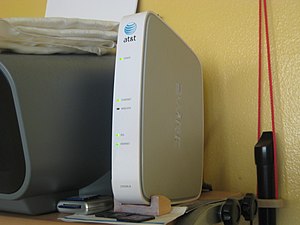In telecommunications, a customer-premises equipment or customer-provided equipment (CPE) is any terminal and associated equipment located at a subscriber's premises and connected with a carrier's telecommunication circuit at the demarcation point ("demarc"). The demarc is a point established in a building or complex to separate customer equipment from the equipment located in either the distribution infrastructure or central office of the communications service provider.
Digital subscriber line is a family of technologies that are used to transmit digital data over telephone lines. In telecommunications marketing, the term DSL is widely understood to mean asymmetric digital subscriber line (ADSL), the most commonly installed DSL technology, for Internet access.

Telecommunications in Australia refers to communication in Australia through electronic means, using devices such as telephone, television, radio or computer, and services such as the telephony and broadband networks. Telecommunications have always been important in Australia given the "tyranny of distance" with a dispersed population. Governments have driven telecommunication development and have a key role in its regulation.

Bell Internet, originally and frequently still called Sympatico, is the residential Internet service provider (ISP) division of BCE Inc. As of May 3, 2012, Bell Internet had over 3 million subscribers in Ontario and Quebec, making it the largest ISP in Canada.

Internet access is a facility or service that provides connectivity for a computer, a computer network, or other network device to the Internet, and for individuals or organizations to access or use applications such as email and the World Wide Web. Internet access is offered for sale by an international hierarchy of Internet service providers (ISPs) using various networking technologies. At the retail level, many organizations, including municipal entities, also provide cost-free access to the general public.
Singtel Optus Pty Limited is an Australian telecommunications company headquartered in Macquarie Park, a suburb in the Northern Sydney region of Sydney, New South Wales, Australia. It is a wholly owned subsidiary of Singaporean telecommunications company Singtel.

Internet Protocol television (IPTV) is the delivery of television content over Internet Protocol (IP) networks. This is in contrast to delivery through traditional terrestrial, satellite, and cable television formats. Unlike downloaded media, IPTV offers the ability to stream the source media continuously. As a result, a client media player can begin playing the content almost immediately. This is known as streaming media.
TransACT is the trading name of TransACT Capital Communications, an Australian telecommunications company based in Canberra which provides broadband internet access, fixed telephony, cable television services, and mobile phone services in Canberra and a subset of these services in Queanbeyan, throughout South-east New South Wales and in Victoria.

In the field of telecommunications, the concept of triple play service refers to the provision of three essential services — high-speed broadband Internet access, television, and latency-sensitive telephone services — all delivered over a single broadband connection. This approach emphasizes the convergence of multiple services by a single supplier, aiming to enhance user convenience and streamline service delivery.
In telecommunications, cable Internet access, shortened to cable Internet, is a form of broadband internet access which uses the same infrastructure as cable television. Like digital subscriber line and fiber to the premises services, cable Internet access provides network edge connectivity from the Internet service provider to an end user. It is integrated into the cable television infrastructure analogously to DSL which uses the existing telephone network. Cable TV networks and telecommunications networks are the two predominant forms of residential Internet access. Recently, both have seen increased competition from fiber deployments, wireless, mobile networks and satellite internet access.

Fiber to the x or fiber in the loop is a generic term for any broadband network architecture using optical fiber to provide all or part of the local loop used for last mile telecommunications. As fiber optic cables are able to carry much more data than copper cables, especially over long distances, copper telephone networks built in the 20th century are being replaced by fiber.

Embarq Corporation was the largest independent local exchange carrier in the United States, serving customers in 18 states and providing local, long-distance, high-speed data and wireless services to residential and business customers. It had been formerly the local telephone division (LTD) of Sprint Nextel until 2006, when it was spun off as an independent company. Embarq produced more than $6 billion in revenues annually, and had approximately 18,000 employees. It was based in Overland Park, Kansas.

Windstream Holdings, Inc., also doing business as Windstream Communications or Windstream, is a provider of voice and data network communications, and managed services, to businesses in the United States. The company also offers residential broadband, phone and digital streaming TV services to consumers within its coverage area. It is the ninth largest residential telephone provider in the country with service covering more than 8.1 million people in 21 states.
Whidbey Telecom is a private, independent telecommunications company operating on the South End of Whidbey Island in Washington State, the community of Point Roberts, Washington, and its affiliate Hat Island Telephone Company on Hat (Gedney) Island. Whidbey Telecom has been locally owned and operated since it started business in 1908.
A residential gateway is a small consumer-grade gateway which bridges network access between connected local area network (LAN) hosts to a wide area network (WAN) via a modem, or directly connects to a WAN, while routing. The WAN is a larger computer network, generally operated by an Internet service provider.
Internet in Australia first became available on a permanent basis to universities in Australia in May 1989, via AARNet. Pegasus Networks was Australia's first public Internet provider in June 1989. The first commercial dial-up Internet Service Provider (ISP) appeared in capital cities soon after, and by the mid-1990s almost the entire country had a range of choices of dial-up ISPs. Today, Internet access is available through a range of technologies, i.e. hybrid fibre coaxial cable, digital subscriber line (DSL), Integrated Services Digital Network (ISDN) and satellite Internet. In July 2009, the federal government, in partnership with the industrial sector, began rolling out a nationwide fibre-to-the-premises (FTTP) and improved fixed wireless and satellite access through the National Broadband Network. Subsequently, the roll out was downgraded to a Multi-Technology Mix on the promise of it being less expensive and with earlier completion. In October 2020, the federal government announced an upgrade by 2023 of NBN fibre-to-the-node (FTTN) services to FTTP for 2 million households, at a cost of A$3.5 billion.
An Intelligent Network Interface Device, more commonly known as an "INID", is a system that provides triple play media services to customer homes. The system provides digital subscriber line access, advanced TV, and voice over internet protocol (VoIP) phone services to subscribed customers. The term may refer either to a standalone external residential gateway or to a system of multiple components that together provide RG functions. Models include the 2Wire HomePortal INID and the Entone Crescendo INID. AT&T's U-verse brand of services employs the 2Wire INID as an alternative residential gateway.
EarthLink is an American Internet service provider.

AT&T Internet is an AT&T brand of broadband internet service. Previously, AT&T Internet was branded as U-verse Internet and bundled with U-verse TV, which was spun off into the newly independent DirecTV in 2021. AT&T Internet plans powered by fiber-optic cable use the AT&T Fiber brand.

Kinetic is the brand name of a suite of telecommunications products and services for residential and business customers which includes fiber broadband internet access, local and long distance telephone service, digital subscriber line transmission, unified communications, internet protocol television, and home security systems. Kinetic is one of three divisions operated by Windstream Holdings, a privately held Fortune 1000 communications and software company. The other units are Windstream Enterprise and Windstream Wholesale. Kinetic wordmark and service mark are registered by Windstream Intellectual Property Services, LLC.











